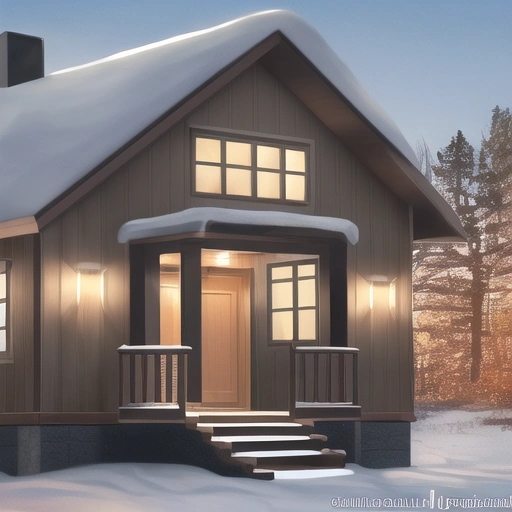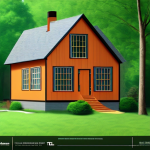Wood vs. Vinyl Siding in Minnesota: Choosing for Cold Climate Durability
Minnesota Siding Showdown: Wood vs. Vinyl in the Face of Winter
Minnesota’s unforgiving winters demand building materials that can withstand extreme cold, heavy snow, and fluctuating temperatures. For homeowners, selecting the right siding is paramount to protecting their investment and maintaining curb appeal. While both wood and vinyl siding are popular choices, understanding their unique strengths and weaknesses in a cold climate is essential for making an informed decision. This article delves into the durability, maintenance, cost, and aesthetic considerations of wood and vinyl siding, providing Minnesota homeowners with the knowledge they need to choose the best option for their homes.
In Minnesota, where temperatures can plummet well below freezing for extended periods, the choice of siding material goes beyond mere aesthetics. It’s a critical decision that impacts a home’s structural integrity, energy efficiency, and long-term maintenance costs. For example, improperly installed or maintained wood siding can quickly succumb to moisture damage and rot, leading to costly repairs. Conversely, while vinyl siding offers inherent moisture resistance, its performance can be compromised by extreme temperature swings, potentially leading to cracking or warping.
Therefore, a nuanced understanding of each material’s properties is crucial for homeowners seeking to make a sound investment in their property. Beyond the immediate concerns of weather resistance, Minnesota homeowners should also consider the long-term implications of their siding choice. Factors such as the frequency of painting or staining required for wood siding, or the potential for fading or discoloration in vinyl siding, can significantly impact the overall cost of ownership. Moreover, the environmental impact of each material should be taken into account.
Wood siding, if sourced sustainably, can be a renewable resource, while vinyl siding is a petroleum-based product with its own set of environmental considerations. By carefully weighing these factors, homeowners can make an informed decision that aligns with their values and budget. Ultimately, selecting the right siding material for a Minnesota home is a balancing act, weighing the aesthetic appeal, durability, maintenance requirements, and cost of both wood siding and vinyl siding. This article aims to provide a comprehensive overview of these considerations, empowering homeowners to make the best possible choice for their specific needs and circumstances. We’ll explore real-world examples of homes in Minnesota that have successfully utilized both wood and vinyl siding, highlighting the key factors that contributed to their long-term performance and aesthetic appeal. By understanding the nuances of each material, Minnesota homeowners can ensure their homes are well-protected and visually appealing for years to come.
The Allure and Challenges of Wood Siding in Cold Climates
Wood siding, prized for its natural beauty and classic appeal, offers several advantages that resonate with Minnesota homeowners seeking a traditional aesthetic. Cedar, redwood, and pine are common choices, each boasting unique grain patterns and varying degrees of natural resistance to rot, insects, and moisture. For instance, cedar contains natural oils that act as preservatives, making it a popular, albeit pricier, option for those prioritizing longevity. Properly treated and meticulously maintained wood siding can last for decades, adding warmth and character that enhances a home’s curb appeal and potentially increases its property value.
This makes it a compelling choice for those undertaking exterior home renovation projects with a focus on long-term investment and visual appeal. However, Minnesota’s harsh winters present unique challenges that demand careful consideration. The state’s dramatic temperature swings and high humidity levels create a perfect storm for wood siding. Repeated freeze-thaw cycles cause the wood to expand and contract, placing immense stress on the material. This can lead to unsightly cracks, warping, and premature paint failure, detracting from the siding’s aesthetic appeal and compromising its protective barrier.
Moisture penetration, exacerbated by snow accumulation around the base of the house and in sheltered areas, can lead to rot and decay, weakening the wood’s structural integrity and potentially attracting wood-boring insects. Choosing the right type of wood and ensuring proper installation techniques are critical first steps in mitigating these risks. Regular maintenance is not merely recommended but is absolutely crucial to protect wood siding from the elements and prevent costly repairs in a cold climate like Minnesota.
This includes annual inspections for signs of damage, prompt repairs to any cracks or damaged areas, and a consistent schedule of painting or staining to maintain a protective seal. Depending on the type of wood and the severity of the weather exposure, homeowners can expect to repaint or restain their wood siding every three to seven years. While this upkeep ensures the siding’s longevity and aesthetic appeal, it can be time-consuming and expensive, adding significantly to the overall cost of ownership and making it a key factor to consider when comparing wood siding with lower-maintenance alternatives like vinyl.
Furthermore, the choice of paint or stain should be climate-specific, opting for products designed to withstand the rigors of freeze-thaw cycles and high moisture levels. Beyond aesthetic and maintenance considerations, the type of wood siding chosen can also influence a home’s energy efficiency. Wood, in general, provides a degree of insulation, helping to regulate indoor temperatures and potentially reduce energy consumption. However, the R-value (a measure of thermal resistance) varies significantly between different wood species and thicknesses.
For example, thicker cedar siding will offer better insulation than thin pine siding. Homeowners undertaking siding installation should consult with experienced contractors to determine the optimal wood type and thickness for their specific energy efficiency goals, taking into account factors such as the home’s orientation, existing insulation levels, and local climate conditions. This holistic approach ensures that the chosen wood siding not only enhances the home’s curb appeal but also contributes to its overall energy performance and reduces long-term energy costs.
Vinyl Siding: A Low-Maintenance Option with Cold-Weather Considerations
Vinyl siding presents itself as a compelling alternative to wood siding, particularly appealing to Minnesota homeowners seeking affordability, minimal upkeep, and inherent resistance to the elements. Constructed from polyvinyl chloride (PVC), vinyl siding excels in repelling moisture, deterring insects, and preventing rot – attributes that make it a seemingly ideal choice for the region’s demanding climate. Unlike wood, which demands regular painting, staining, and sealing, vinyl siding largely eliminates these chores, translating to significant long-term savings and convenience.
The initial cost of siding installation is also typically lower with vinyl, making it an attractive option for budget-conscious homeowners embarking on exterior home renovation projects. However, it’s crucial to acknowledge the nuances of vinyl’s performance in extreme cold, a factor that demands careful consideration in Minnesota’s climate-specific exterior material selection. Despite its advantages, vinyl siding is not impervious to the challenges posed by Minnesota’s harsh winters. The very composition that lends vinyl its resilience can also become a liability when temperatures plummet.
In extreme cold, vinyl becomes more brittle, increasing its susceptibility to cracking or breaking upon impact. This is especially pertinent during siding installation, where careful handling is paramount to prevent damage. Hailstorms and falling branches, common occurrences in Minnesota, can also inflict damage more readily on cold, brittle vinyl. Furthermore, while vinyl itself is water-resistant, improper siding installation can create pathways for moisture to become trapped behind the siding. This trapped moisture can lead to the growth of mold and mildew, potentially compromising the structural integrity of the home and posing health risks.
Therefore, selecting a qualified and experienced siding installation contractor is essential to ensure proper sealing and ventilation, mitigating the risk of moisture-related problems. Beyond its performance characteristics, the aesthetic dimension of vinyl siding also warrants careful consideration. While advancements in manufacturing have expanded the range of colors, textures, and styles available, some homeowners find that vinyl siding lacks the natural warmth and character of wood siding. The simulated wood grain patterns, while improving, may not fully replicate the authentic look and feel of cedar or redwood.
For homeowners prioritizing a classic, natural aesthetic, this can be a significant drawback. However, the ongoing evolution of vinyl siding technology continues to address these concerns, with manufacturers introducing more realistic textures and profiles that more closely mimic the appearance of wood. Ultimately, the decision to opt for vinyl siding involves weighing its practical advantages against its aesthetic limitations, aligning the choice with individual preferences and priorities within the context of a Minnesota home improvement project.
Durability Face-Off: Wood vs. Vinyl in Minnesota’s Winter
When evaluating durability in cold climates, both wood and vinyl siding present a complex equation of strengths and weaknesses, particularly for Minnesota homeowners. Wood siding, celebrated for its natural aesthetic, can indeed withstand the elements for many years with diligent upkeep. However, the freeze-thaw cycle inherent to Minnesota winters poses a significant challenge. The constant expansion and contraction of wood fibers due to temperature fluctuations can accelerate wear and tear, leading to cracks, warping, and ultimately, a compromised exterior.
For example, improperly sealed wood siding can absorb moisture during the spring thaw, which then freezes and expands within the wood during the next cold snap, exacerbating damage. This underscores the critical need for meticulous maintenance, a key consideration in climate-specific exterior material selection. Vinyl siding, conversely, is generally more resistant to moisture and rot, a definite advantage in Minnesota’s often-damp climate. However, its susceptibility to cracking in extreme cold is a well-documented concern. While modern vinyl formulations have improved cold-weather performance, the material can become brittle at sub-zero temperatures, increasing the risk of impact damage from hail, falling branches, or even just routine contact.
This is especially relevant for homeowners undertaking exterior home renovation projects, as older vinyl siding may be more prone to such issues. Proper siding installation techniques, such as using flexible caulk and allowing for expansion gaps, are crucial to mitigating these risks and ensuring long-term durability. The key to long-term durability for both wood and vinyl siding lies in proper installation and ongoing maintenance, emphasizing the importance of informed decision-making for Minnesota homeowners. For wood siding, this means regular painting or staining with high-quality, weather-resistant products, sealing joints and edges to prevent moisture penetration, and promptly addressing any signs of rot, decay, or insect infestation.
Neglecting these maintenance tasks can significantly shorten the lifespan of wood siding and lead to costly repairs. For vinyl siding, proper installation with adequate expansion joints to accommodate temperature changes is paramount. Furthermore, regular cleaning to remove dirt, mold, and mildew can help maintain its appearance and prevent moisture buildup behind the siding. Choosing experienced siding installation professionals familiar with Minnesota’s unique climate is a worthwhile investment for any home improvement project. Beyond installation and immediate repairs, consider the long-term effects of Minnesota’s climate on both materials.
Wood siding, while initially more expensive in some cases, may require significant reinvestment over time due to the need for regular repainting and repairs. Vinyl siding, though often touted as a low-maintenance option, can still suffer from fading or discoloration due to prolonged exposure to the sun, potentially impacting curb appeal and requiring eventual replacement. Therefore, a comprehensive assessment of life-cycle costs, encompassing both initial investment and ongoing maintenance, is essential when selecting siding materials for a Minnesota home. This holistic approach ensures that the chosen siding not only withstands the elements but also aligns with the homeowner’s budget and long-term aesthetic preferences.
Cost and Energy Efficiency: Making a Budget-Conscious Choice
The upfront cost is a critical factor for many Minnesota homeowners contemplating siding replacement. The price of both wood siding and vinyl siding fluctuates based on wood species – cedar and redwood command a premium – and vinyl quality, with thicker gauges and enhanced UV resistance adding to the expense. Installation costs also vary depending on the complexity of the project and labor rates in your area. Generally, vinyl siding installation is less expensive than wood siding installation, primarily due to the lighter material and faster installation process.
However, focusing solely on initial outlay can be misleading; a comprehensive financial perspective demands consideration of long-term expenses. Therefore, homeowners must consider the total cost of ownership, encompassing materials, siding installation, and, critically, ongoing maintenance, when making their decision. For example, a homeowner might save $5,000 on initial vinyl siding installation, but spend $500 annually on power washing and repairs, whereas a more expensive wood siding might only require staining every 5-7 years at a similar cost.
Beyond the immediate and recurring expenses, energy efficiency plays a pivotal role in the overall cost-effectiveness of siding. Both wood siding and vinyl siding offer some degree of insulation, contributing to reduced energy consumption. However, strategically incorporating insulation behind the siding significantly amplifies energy performance. This is particularly relevant in Minnesota’s extreme climate, where minimizing heat loss during frigid winters is paramount. Insulated vinyl siding, featuring a foam backing, presents an attractive option, creating a thermal barrier that mitigates heat transfer and potentially lowers monthly energy bills.
Consider that a well-insulated home with energy-efficient siding not only reduces heating costs but also enhances overall comfort and increases the home’s resale value, a significant long-term benefit. Furthermore, the impact of siding color on energy efficiency is often overlooked. Lighter-colored siding reflects more sunlight, reducing heat absorption during the summer months and potentially lowering cooling costs. Conversely, darker-colored siding absorbs more heat, which could be advantageous during the winter but might lead to higher cooling bills in the summer. Therefore, when selecting siding, homeowners in Minnesota should carefully consider the color in relation to their home’s orientation and the local climate. For instance, a south-facing wall might benefit from lighter-colored siding to minimize heat gain. These subtle considerations, combined with appropriate insulation, can result in substantial long-term savings on energy bills, making energy efficiency a crucial factor in the wood versus vinyl siding decision.
The Verdict: Choosing the Right Siding for Your Minnesota Home
Choosing between wood siding and vinyl siding for a Minnesota home is a complex decision, a true balancing act that demands careful consideration of durability in a cold climate, ongoing maintenance requirements, upfront and long-term costs, and, of course, aesthetic preferences. Wood siding, with its undeniable classic and natural look, evokes a sense of warmth and timelessness that resonates with many homeowners. However, this beauty comes at a price: regular and diligent maintenance is essential to protect it from the harsh Minnesota winter elements, including snow, ice, and dramatic temperature swings.
Factors such as the direction your home faces, the amount of sun exposure it receives, and the quality of the initial siding installation all play a role in determining how well wood siding will hold up over time. Vinyl siding, on the other hand, presents itself as a more affordable and lower-maintenance home improvement option, appealing to budget-conscious homeowners seeking a practical solution. Its resistance to moisture, rot, and insect infestation makes it a compelling choice in a region where these issues can be prevalent.
However, it’s crucial to acknowledge vinyl’s susceptibility to cracking and becoming brittle in extreme cold, a significant concern in Minnesota. While advancements in vinyl siding technology have improved its cold-weather performance, homeowners should carefully research the specific product’s temperature rating and impact resistance before making a decision. Consider that darker colors of vinyl siding tend to absorb more heat, potentially leading to warping or fading over time, an important factor for energy efficiency. Ultimately, the best siding solution for your Minnesota home depends on your individual needs, priorities, and tolerance for maintenance.
Are you willing to invest the time and resources required to properly maintain wood siding, preserving its natural beauty and extending its lifespan? Or do you prioritize the convenience and affordability of vinyl siding, accepting its potential limitations in extreme cold? Beyond the material itself, proper siding installation is paramount. A poorly installed siding, regardless of material, will be more vulnerable to the elements and lead to premature failure. Consulting with a qualified and experienced siding contractor specializing in Minnesota’s climate can provide invaluable insights, helping homeowners weigh the pros and cons of each option and make an informed decision that will protect their homes and enhance their curb appeal for years to come. Furthermore, exploring options like insulated vinyl siding can boost energy efficiency, potentially offsetting some of the initial cost.


